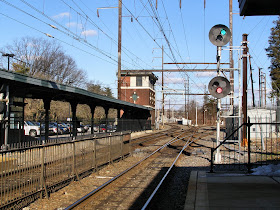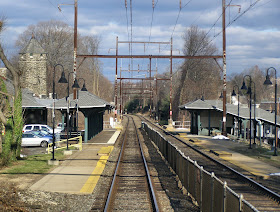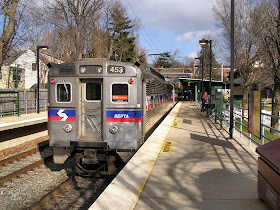You can see a Google Map of the trip route here and at 63 miles this is one of the shorter Mid-Winter trips. This was because instead of traveling long distances I decided to include a pair of extended photo stops on the Regional Rail in the hopes of catching some Silverliner IIs and IIIs. While we were to be a bit disappointed on that front it was still a great trip.
You can view the entire set of photos in chronological order here: http://acm.jhu.edu/~sthurmovik/Railpics/09-12-28_MID-WINTER_TRIP_IX/-Thumbnails.html
The Trip started off with a little informal event. I was looking for a way to get some front end video on a PATCO Express run without getting bitched at by the operator. The solution was to involve team play where strategically placed railfans should block the view of the operator with a newspaper allowing the railfan with the camera to shoot unmolested. That part of the plan worked like a charm, but unfortunately PATCO had canceled all of its express services in the week between Christmas and New Year. Anyway, here is the result, a video of a standard local run between Woodcrest and Haddonfield through a very dirty window.
So while PATCO was a bit of a bust the official trip began with a Regional Rail ride to Jenkintown where we would hang out for a bit to photograph the parade of RRD trains passing through the busy junction there. While out on the 4-track Reading trunk line I began to take some photos out the front window before opting to get some video through 16th St junction as we paced another RR train. Unfortunately an asshole trainee in hanging out in the front cab had other ideas.
See why I might be a little hostile to the "concerns" of SEPTA crews about half-width cabs on the S-Vs?
JENKIN interlocking at Jenkintown is the junction between the SEPTA Main Line (R's 1,2 and 5) and the Neshaminy Line (R3). Even though it was recently rebuilt and outfitted with useless Metro North style signals. Here is our R5 train, jerk crew and all, departing Jenkintown taking the left hand route on a Cab Speed signal.
JENKIN tower still stands and there is more than ehough hot SEPTA MU action. One can consider Jenkintown as the Mineola or South Norwalk of the SEPTA system.
As the former movable point diamond was replaced by a pair of turnouts just about the only interesting bit of signaling left at JENKIN is this twin mast of Safetran Unilens solid state searchlight signals needed to fit under the platform canopy.
Jenkintown could also be considered the Metro Park of the Reading, providing an important Suburban stop for its premier Philadelphia to New York train, The Crusader. As such the station was fitted with full length covered platforms, a handsome granite station building, and convenient facilities for drop off and pick up. BTW can you spot the railfans in this photo?
There was some weird single tracking going on on the R3 so here we see SEPTA S-IV #170 arriving inbound on the wrong platform.
Front view of JENKIN tower. The tower had its top floor replaced around 1990, but had probably been closed as an active tower sometime before then. It's functions were transfered to the WIND panel in WAYNE tower.
SEPTA S-IV #446 brings up the rear on an outbound R2 train. About 2 miles up the Main Line it will diverge at CARMEL interlocking onto the Warminster Line.
Here S-IV #452 brings up the rear of an R3 train running on the proper track outbound from Center City as it takes the right hand route at JENKIN.
SEPTA S-IV #294 arrives from the Main Line with three SEPTA crew-members stuffed into the front cab.
SEPTA S-IV #128 then showed up next on the train we would need to take to Fern Rock. There was some sort of service disruption going on so these trains were pretty full. Of course the front cab had its usual compliment of three SEPTA crewmembers. Does anyone notice a pattern here?
Elkins Park station as seen from the rear of our RR train shortly before an outbound train with S-IV #398 arrived. Already the lacks of S-IIs and IIIs was becoming irritating.
SEPTA B-IV car #561 rounds the loop at Fern Rock.
At Fern Rock the part of the group I was on took an express train to Girard and then caught a Ridge Line train to North Philadelphia.
Holy Station Renovations Batman!! Stimulus funds at work at Girard.
Phil N chats up the driver of a Ridge Line train at North Philadelphia about why the train sounds like its been equipped with some sort of solid state control system.
Before departing the BSS platform at North Philadelphia I caught video of two express trains passing in the station.
The new northern entrance to the North Philly station has been re-opened with HEETs.
The tile work in the passage to the PRR station had been restored as well.
On the Platform at North Philadelphia station we were not disappointed for action when an R7 lead by S-IV #381 showed up.
Then Amtrak #659 hauling a regional.
That previously shown R7 takes the signal at the new LEHIGH interlocking with S-IV #166 on the rear.
North Philadelphia Station has lost some of its tracks, but a good deal of the original overhead catenary infrastructure remains.
AX Power car #2003 heads northbound.
Positioned at the opposite end of the platform AEM-7 #908 shows up with a Southbound Regional passing under the signal bridge at CLEARFIELD interlocking.
Clear signals are displayed on both #3 and #4 track west on the famous 6-track signal gantry at what is now LEHIGH interlocking. LEHIGH and CLEARFIELD replaced the original sprawling NORTH PHILADELPHIA interlocking between 2000 and 2006.
A northbound Long Distance train on track #1 (I believe the Crescent) passes Southbound Acela Express lead by power car #2009.
Closer view of 2009. 2020 was on the rear.
The other shoe dropped when a southbound Regional with 907 on the front showed up on track #4.
I was a bit out of position, but we finally got some NJT action with #4210 with a westbound ACL train.
We were hoping for some S-IIs on the R8, but we were let down again when S-IV #394 showed up More frustratingly after we had boarded the westbound train arrived with a pair of S-IIs. Note the 5W signal is displaying Medium Clear for the approaching westbound train. Amtrak likes to make the R8 flat crossings in paralell to avoid tying up the NEC twice per hour.
The R8 didn't have the same problem with ignorant employees. Here is the construction work at Allen Lane station to add a high level platform.
Extended video documenting the arrival at Chestnut Hill West by our R8 train. You can see the deep rock cut the PRR needed to make in order to reach its destination. It's not called Chestnut HILL for nothing. Also visible is the PRR era interlocking plant and small interlocking tower that distinguished the PRR's capitol resources compared to that of the rival Reading's...which until recently made do with a non-interlocked spring switch at Chestnut Hill East. Note the can signal change after the train passed the Restricting aspect on the pedestal type home signal.
SEPTA S-IV #453 at Chestnut Hill West.
What is called AUSTIN tower is just the C&S/MoW base for the line. I am unsure if this tower was ever called that in PRR service and I suspect that the name was applied by SEPTA to honor some employee. For years control of the interlocking was from an office in the CHW station building using a 2 lever "table interlocker". Control was transfered to A tower on the Airport Line before the towers were replaced by dispatchers.
View of the interlocking showing the crossover, derails and pedestal type exit ABS signal. All points are pneumatic in the proud PRR tradition.
The 01 and 02 derails are provided due to the extreme grade on the line approaching the station making runaway cars a real risk.
I support the sentiment, but not the transportation mode. There is no good reason why there should be buses on the "temporarily suspended" Rt 23 loop at Chestnut Hill.

A long string of S-IVs (GRRRR) were waiting at Chestnut Hill East with #333 closest to the bumper blocks.
Reading company electric Substation at CHE. The power on the CHW is supplied from Amtrak's 25Hz grid. Power at CHE is supplied by SEPTA's former Reading RR grid.
The new SPRING interlocking replaced the former spring switch at the mouth of the CHE terminal complex. It is still trailing point only.
While the signals on the Chestnut Hill East line have not yet been replaced by cabs, all of the old heads have been replaced by new LED target type signals.
At Wayne Junction the writing is still on the wall for service long since suspended.
Due to half of the trip participants not knowing how to read a clock they missed the hour headway R7 departure and got stuck at Chestnut Hill. I suggested that they ride a Rt 23 bus as a punishment, but they refused. This gave us another extended photo shoot at Wayne Jct while waiting for a Rt 75 Trackless Trolley. Still, even with more RRD time our SII/III luck continued to suck. Here S-IV #439 pokes its nose out from behind one of the old station structures on the low level R7 platform.
A double Reading lozenge signal mast governs southbound trains from the CHE line into WAYNE interlocking.
A pair of twin stack US&S H-5 signals govern track three while a more traditional Reading type mast guards #2 track. The mast was LEDized without head replacement.
Another S-IV, #168, on an outbound R3 knocks down the signal on track #2.
At the opposite end of the platform we see that while WAYNE tower may be closed, it still stands proud.
Gantry mounted old school US&S color light type signals show you can teach and old god new tricks with an LED upgrade package.
That track #2 mast signal this time showing Approach with a good view of the trains hanging out on the front lawn of the Wayne Junction shoppes.
An inbound R1 Airport with, you guessed it, S-IV #446 in the lead was the last Regional Rail train of the day. For all of the RR trains we encountered not a one was an S-II or III. :-(
There were some wire problems in the Wayne Junction area so the Rt 75 trackless trolleys were using their auxiliary diesel generators to get past the disruption.
To reach the Rt 75 stop one must traverse the CSX Trenton Line which is running in a cut. This former Reading freight line ran from Falls Junction up to Newtown Junction where it would then link with the Fox Chase Line to Cheltenham Junction as part of the New York Short Line. From there it would run to Neshaminy Jct where it would re-join the longer passenger line to West Trenton.
Our trackless trolley to Arrott Terminal was to be number 808.
There we caught #822 on the Rt 59 with its poles actually up.
Those trip attendees who missed their train at Chestnut Hill west were rewarded with a pull-in Rt 75 run that took them direct to Frankford Terminal. The punctual participants had to walk along the center pier elevated structure.
After transferring to the MFL the disparate groups were able to re-join eventually getting off at Girard for a group photo. You know who you are ;-)
There were also MFL trains at Girard too.
No Mid-Winter trip would be complete without a trip on the Rt 15 and its PCC IIs. Here is #2321 at the Westmoreland Loop.
We were blessed when the PCC with the Christmas Lights pulled up into the on-deck circle.
I took the first PCC II to depart in order to catch the lights car at the Port Richmond Overpass that would soon be removed in a multi year project that will shut down the Rt 15 north of the new Sugarhouse Loop.
Here is PCC II #2320 about to pass under the former Reading RR freight tracks to their major export terminal at Port Richmond.
The bridges and their low overhead trolley wire frequently snares unwary trucks. This comically large sign helps prevent such occurrences.
The Christmas Car #2324 passing under the bridge.
#2324 emerging from the underpass with the large sign.
#2324 with the rest of the participants on board as it arrives at the stop. Note to Railfans...you cannot take pictures of a vehicle YOU ARE CURRENTLY RIDING.
Last photo of the day, #2324 at Girard before the attendees split up to head their various ways.
Hope you enjoyed the trio and I encourage all of you to come out for Mid Winter Trip X scheduled for Monday, December 27th at 8:55am departing Market East, cost 1 $11 Independence Pass. It will be great!!






























































No comments:
Post a Comment